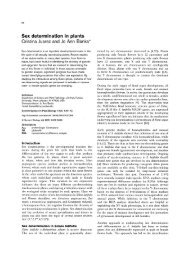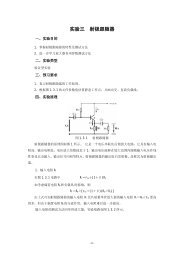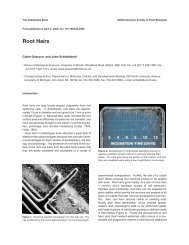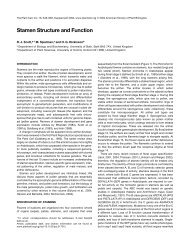Pollen and Stigma Structure and Function: The Role of Diversity in ...
Pollen and Stigma Structure and Function: The Role of Diversity in ...
Pollen and Stigma Structure and Function: The Role of Diversity in ...
You also want an ePaper? Increase the reach of your titles
YUMPU automatically turns print PDFs into web optimized ePapers that Google loves.
S88<br />
<strong>The</strong> Plant Cell<br />
<strong>Pollen</strong> Polarization <strong>and</strong> Germ<strong>in</strong>ation: Prepar<strong>in</strong>g<br />
for <strong>Pollen</strong> Tube Growth<br />
Hydration transforms a pollen gra<strong>in</strong> from a nonpolar cell to<br />
a highly polarized cell. Whether tubes emerge on a dry stigma<br />
surface, from a gra<strong>in</strong> submerged <strong>in</strong> stigma exudates, or from<br />
pollen germ<strong>in</strong>ated <strong>in</strong> vitro, the gra<strong>in</strong> organizes its cytoplasm<br />
<strong>and</strong> cytoskeleton to support the extension <strong>of</strong> a s<strong>in</strong>gle tube.<br />
<strong>The</strong>se changes occur with<strong>in</strong> m<strong>in</strong>utes after hydration <strong>and</strong><br />
<strong>in</strong>clude the formation <strong>of</strong> filamentous cytoskeletal structures<br />
that wrap around the nuclei, act<strong>in</strong> cytoskeleton polarization<br />
toward the site <strong>of</strong> tube emergence (Tiwari <strong>and</strong> Polito, 1988;<br />
Heslop-Harrison <strong>and</strong> Heslop-Harrison, 1992), reorientation <strong>of</strong><br />
the large vegetative nucleus so that it enters the extend<strong>in</strong>g tube<br />
before the generative cells (Heslop-Harrison et al., 1986a;<br />
Heslop-Harrison <strong>and</strong> Heslop-Harrison, 1989; Lalanne <strong>and</strong><br />
Twell, 2002), assembly <strong>of</strong> mitochondria <strong>and</strong> polysaccharide<br />
particles at the site <strong>of</strong> the elongat<strong>in</strong>g tube tip (Cresti et al.,<br />
1977, 1985; Maz<strong>in</strong>a et al., 2002), <strong>and</strong> selection <strong>of</strong> the pollen<br />
plasma membrane for secretory vesicle target<strong>in</strong>g <strong>and</strong> deposition<br />
<strong>of</strong> callose (b-1!3 glycan) at the site <strong>of</strong> tube emergence<br />
(Johnson <strong>and</strong> McCormick, 2001).<br />
It is not yet clear how the polarization signal is perceived <strong>and</strong><br />
subsequently transduced to select a s<strong>in</strong>gle po<strong>in</strong>t for tube<br />
emergence. Several c<strong>and</strong>idate signals have been suggested,<br />
<strong>in</strong>clud<strong>in</strong>g water, lipids, <strong>and</strong> ions (Feijo et al., 1995; Lush et al.,<br />
1998; Wolters-Arts et al., 1998). Evidence for water as a polarity<br />
signal has come from <strong>in</strong> vitro experiments with Nicotiana<br />
pollen: immers<strong>in</strong>g these gra<strong>in</strong>s <strong>in</strong> purified lipids or <strong>in</strong> stigma<br />
exudates, <strong>and</strong> provid<strong>in</strong>g a nearby aqueous <strong>in</strong>terface, results <strong>in</strong><br />
polarized growth toward the aqueous medium, mimick<strong>in</strong>g<br />
behavior <strong>in</strong> vivo. <strong>The</strong> pollen tubes emerge from the aperture<br />
closest to the hydrophobic–aqueous <strong>in</strong>terface, suggest<strong>in</strong>g that<br />
the source <strong>of</strong> water provides directional cues that establish<br />
polarity (Lush et al., 1998; Wolters-Arts et al., 1998). Not only<br />
does this example implicate water, it also suggests a role for<br />
lipids <strong>in</strong> establish<strong>in</strong>g polarity. Additional support for this idea<br />
comes from mutants that lack the lipid-rich pollen coat<strong>in</strong>g<br />
(Preuss et al., 1993; Hülskamp et al., 1995). As described<br />
above, such gra<strong>in</strong>s are unable to hydrate or germ<strong>in</strong>ate on the<br />
stigma. Coat-deficient gra<strong>in</strong>s do hydrate at <strong>in</strong>creased ambient<br />
humidities, but because they lack key axial <strong>in</strong>formation, their<br />
pollen tubes <strong>of</strong>ten emerge at r<strong>and</strong>om orientations relative to<br />
the stigma (Dick<strong>in</strong>son, 1995).<br />
Polarization signals ultimately trigger the recruitment <strong>of</strong> RHO<br />
OF PLANTS1 (ROP1), a GTP b<strong>in</strong>d<strong>in</strong>g prote<strong>in</strong> <strong>in</strong>volved <strong>in</strong> F-act<strong>in</strong><br />
dynamics <strong>and</strong> the establishment <strong>of</strong> calcium gradients at tube tips<br />
(Gu et al., 2003). ROP1, with its b<strong>in</strong>d<strong>in</strong>g partner ROP INTERACT-<br />
ING CRIB-CONTAINING1 prote<strong>in</strong>, localizes to the tip <strong>of</strong> the<br />
grow<strong>in</strong>g pollen tube, where they act to focus secretory vesicle<br />
delivery (Kost et al., 1999; Li et al., 1999; Wu et al., 2001). Other<br />
prote<strong>in</strong>s that preferentially localize to the grow<strong>in</strong>g pollen tube<br />
tip may play a role <strong>in</strong> the <strong>in</strong>itial establishment <strong>of</strong> cell polarity.<br />
One c<strong>and</strong>idate, found at the tips <strong>of</strong> elongat<strong>in</strong>g fern rhizoids,<br />
is annex<strong>in</strong>, a prote<strong>in</strong> believed to be <strong>in</strong>volved <strong>in</strong> tip-oriented<br />
exocytosis events; annex<strong>in</strong>s exhibit calcium-dependent b<strong>in</strong>d<strong>in</strong>g<br />
to phospholipids, affect cytoskeletal structure, <strong>and</strong> potentially<br />
modulate voltage-dependent Ca 21 channels (Clark et al., 1995).<br />
<strong>Pollen</strong> activation promises to be a particularly rich subject for<br />
studies <strong>in</strong>tegrat<strong>in</strong>g the external cues <strong>and</strong> <strong>in</strong>ternal signal<br />
molecules necessary for global rearrangements <strong>and</strong> polarized<br />
tip growth.<br />
Once the cell has established its <strong>in</strong>ternal polarity relative to an<br />
external signal, the pollen tube must breach the ex<strong>in</strong>e wall to<br />
emerge from the gra<strong>in</strong>. Depend<strong>in</strong>g on the species exam<strong>in</strong>ed,<br />
pollen tubes either grow out <strong>of</strong> the apertures or break directly<br />
through the ex<strong>in</strong>e wall. In rye <strong>and</strong> eucalyptus, tubes emerge<br />
strictly at the apertures, by dissolv<strong>in</strong>g apertural <strong>in</strong>t<strong>in</strong>e layers,<br />
ruptur<strong>in</strong>g the th<strong>in</strong> sporopollen<strong>in</strong> wall, <strong>and</strong> displac<strong>in</strong>g the opercula<br />
that guard these sites (Heslop-Harrison, 1979b; Heslop-Harrison<br />
<strong>and</strong> Heslop-Harrison, 1985; Heslop-Harrison et al., 1986b). In<br />
Arabidopsis, whose pollen has three dist<strong>in</strong>ct apertures, pollen<br />
tubes <strong>of</strong>ten break directly through <strong>in</strong>teraperture ex<strong>in</strong>e walls<br />
precisely at the site <strong>of</strong> contact with the stigma surface (Figure<br />
1E). Regardless <strong>of</strong> exit site, pollen tube escape requires either (1)<br />
ex<strong>in</strong>e weaken<strong>in</strong>g by enzymatic digestion from the <strong>in</strong>side or<br />
outside <strong>of</strong> the wall, or (2) ex<strong>in</strong>e tear<strong>in</strong>g by local gel-swell<strong>in</strong>g forces<br />
or focused turgor pressure. Evidence for the former possibility<br />
comes from reports <strong>of</strong> significant ex<strong>in</strong>e remodel<strong>in</strong>g after contact<br />
with the stigma (Gherard<strong>in</strong>i <strong>and</strong> Healey, 1969; Dick<strong>in</strong>son <strong>and</strong><br />
Lewis, 1974). Gel-swell<strong>in</strong>g forces or turgor pressure also could<br />
play important roles, but because such forces radiate <strong>in</strong> all<br />
directions, they must be focused at the site <strong>of</strong> emergence. A<br />
comb<strong>in</strong>ation <strong>of</strong> mechanisms is most likely, with the <strong>in</strong>creased<br />
turgor pressure <strong>of</strong> the pollen gra<strong>in</strong> contribut<strong>in</strong>g to the rupture <strong>of</strong><br />
a patch <strong>of</strong> partially degraded ex<strong>in</strong>e at the pollen–stigma <strong>in</strong>terface.<br />
<strong>The</strong>re is evidence that pollen gra<strong>in</strong>s are preset to harness<br />
biomechanical forces for pollen tube emergence; dead pollen<br />
gra<strong>in</strong>s are able to hydrate to the same extent as liv<strong>in</strong>g gra<strong>in</strong>s,<br />
swell, alter apertural cover<strong>in</strong>gs, <strong>and</strong> even germ<strong>in</strong>ate short tubes<br />
before the tubes ultimately rupture (Heslop-Harrison, 1979b).<br />
<strong>The</strong> challenge <strong>of</strong> purify<strong>in</strong>g factors that regulate cell polarity <strong>and</strong><br />
tube emergence calls for the use <strong>of</strong> complementary genetic<br />
strategies. For example, mutations that upset the physical<br />
association between the two Arabidopsis sperm cells <strong>and</strong> the<br />
vegetative pollen nucleus have been identified. <strong>The</strong>se mutations<br />
disrupt the polarized transport <strong>of</strong> the male germ unit to the pollen<br />
tube tip by (1) separat<strong>in</strong>g the vegetative nucleus from the two<br />
sperm cells (germ unit malformed1 [gum1] <strong>and</strong> gum2) or (2)<br />
mislocaliz<strong>in</strong>g an <strong>in</strong>tact male germ unit to the pollen wall (mgu<br />
displaced1 [mud1] <strong>and</strong> mud2) (Lalanne <strong>and</strong> Twell, 2002). Other<br />
visual screens have identified mutations that allow tubes to grow<br />
without emerg<strong>in</strong>g from the gra<strong>in</strong> or disrupt the accumulation <strong>and</strong><br />
deposition <strong>of</strong> callose before pollen tube emergence (Johnson<br />
<strong>and</strong> McCormick, 2001). In addition, screens for pollen gametophytic<br />
mutations have yielded mutants altered <strong>in</strong> germ<strong>in</strong>ation,<br />
polarity, <strong>and</strong> tube emergence (Ryan et al., 1998; Gr<strong>in</strong>i et al., 1999;<br />
Johnson <strong>and</strong> McCormick, 2001; Procissi et al., 2001; Johnson<br />
<strong>and</strong> Preuss, 2002; Lalanne <strong>and</strong> Twell, 2002). Similar approaches<br />
have not yet yielded stigma-specific mutations, despite numerous<br />
screens to isolate sporophytic sterile mutants. This<br />
deficiency suggests functional redundancy <strong>in</strong> the pollen-recognition<br />
mach<strong>in</strong>ery <strong>in</strong>volved. On the other h<strong>and</strong>, the fertility <strong>of</strong><br />
Arabidopsis flowers with genetically ablated stigma cells (K<strong>and</strong>asamy<br />
et al., 1993; Thorsness et al., 1993) calls <strong>in</strong>to question<br />
the absolute requirement for the tissue.








